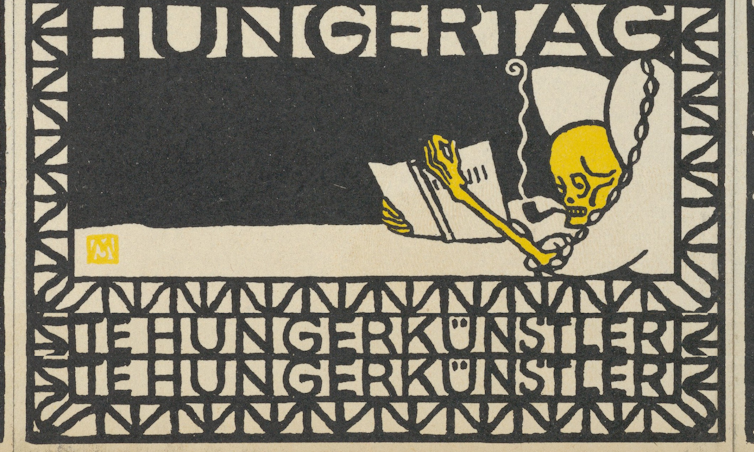There is a rather potent image of failure which recurs in the short stories and novels of Franz Kafka, the Czech writer who died of tuberculosis 100 years ago. The image is of a young man brimming with self-assurance who, without warning, is assailed by some irreproachable authority. He protests, but his fate is sealed. The verdict is guilty. His sentence is death.
That this young man’s sudden misfortune is often foreshadowed by a sudden loss of appetite reflects a persistent theme in Kafka’s work. He is consumed by the problem of finding adequate nourishment.
You can find it in The Trial (1925) where Joseph K. notes that his unexpected arrest for an unspecified crime was preceded by the non-arrival of breakfast.
It’s in The Judgement (1912) where Georg Bendemann observes that his bullying and domineering father had barely touched his breakfast. Then, after a bitter confrontation, Georg runs to a nearby bridge intending to throw himself off. He grips the rails “as a starving man grasps at food”.
And, it’s in his most famous work, The Metamorphosis (1915). “I’ve got appetite enough”, complains the giant bug Gregor Samsa, “but not for things of that kind”.

This article is part of our series marking 100 years since the death of writer Franz Kafka. These articles explore his legacy and influence on everything from cinema to law. To read more click here
Kafka makes the biographical connection obvious. In his diaries (newly translated by Ross Benjamin), Kafka noted that “Georg” has the same number of letters as “Franz”, and that “Bende” (as in “Bendemann”) the same consonant and vowel structure as “Kafka”. (“Samsa”, we might add, indulges in the same wordplay).
The connection between good health and good nourishment also dominated Kafka’s thoughts long before tuberculosis swelled his throat to make eating practically impossible. To ease the migraines, insomnia and other ailments which stifled his creativity, Kafka cut meat from his diet and consumed, like Gregor Samsa, vast quantities of unpasteurised milk.
But the problem of appetite could also be pathological.
Of the self-doubts which periodically plagued Kafka’s creativity, he wryly noted that, like a dog, he could be content to “leap out when he is given food and to leap back when he has devoured it.” Just six months earlier, he wrote a letter to his friend composer Max Brod detailing a violent fantasy: “I lie stretched out on the floor, sliced up like a roast, and with my hand am slowly pushing a slice of the meat toward a dog in the corner.”
In a word, Kafka preferred death to obedience. He preferred the idea of being consumed than of blindly consuming what life had served up. (Lurking in the background, always, was the brutish and domineering father he could not satisfy, nor separate from).
It is perhaps fitting then, that one of his final stories is about the refusal of all sustenance.
In A Hunger Artist (1922), a man fasts in a cage for 40 days to entertain crowds of eager onlookers. To ensure he doesn’t cheat, public representatives (usually butchers) watch him day and night. However, as the audience’s appetite for pleasure changes, his popularity wanes.
The hunger artist ends up at a circus pushed to the side of a thoroughfare (en route to the animals), little observed. After countless days fasting, an overseer discovers him on the brink of death.
“I have to fast,” he whispers, “because I could never find the nourishment I liked. Had I found it, believe me, I would never have caused any stir, and would have eaten my fill just like you and everyone else.” After his death, the hunger artist is unceremoniously buried. In what was his cage, a rapacious panther now proudly stands. The crowds return.

Among Kafka’s letters, his friend the American lung surgeon Robert Klopstock recounted that around the time Kafka was finishing the proofs of this final collection, he was literally starving to death. Moved by the “tremendous psychological effort and a shattering intellectual reencounter with himself,” observed Klopstock, “tears rolled down his cheeks for a long time” – a rare expression of emotion from a writer who “had always shown a superhuman self-control”.
In Kafka, it is often what we refuse, and what we refuse to share, that reveals us. “The power to say no,” he noted in his diary, is the “most natural expression of the perpetually changing, renewing, dying reviving human fighting organism” and it “is something we always have”. In Kafka’s writing, we are defined by what we find the courage to say “no” to, it is an expression of the demand for better nourishment.

